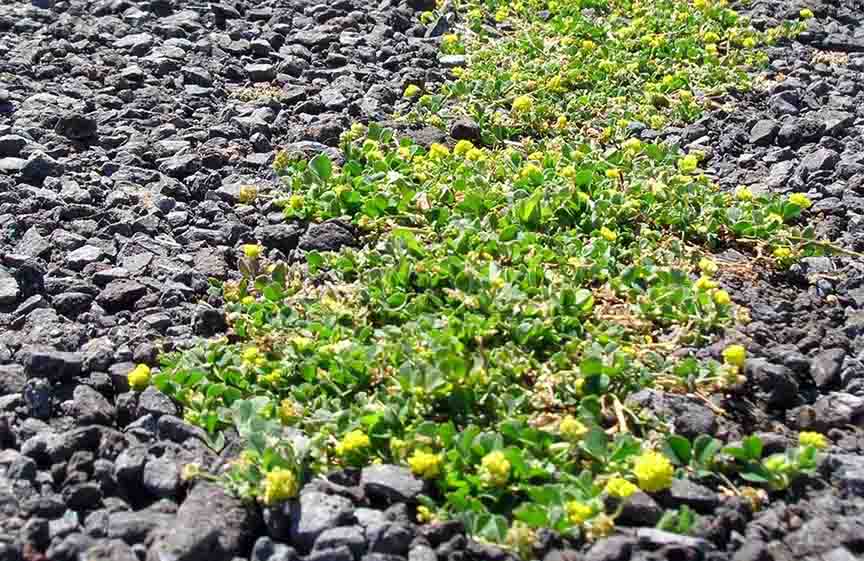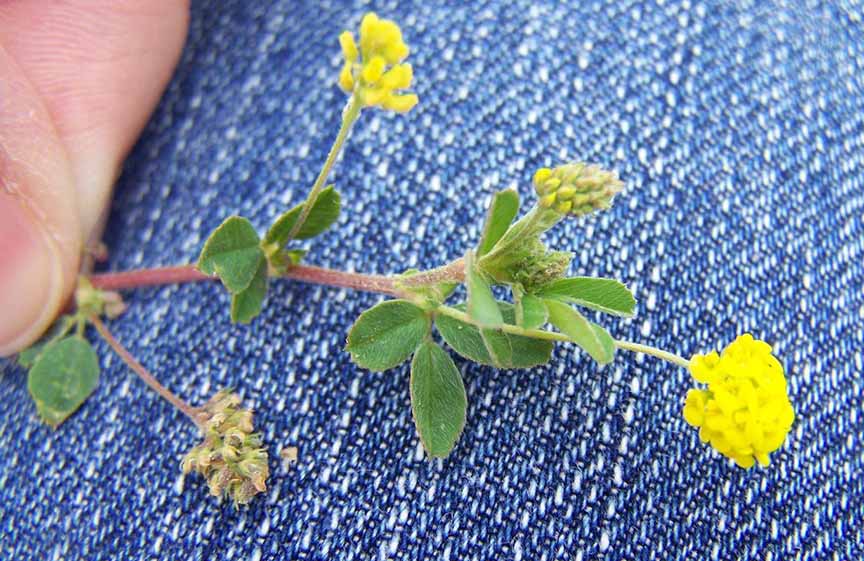Black Medic
Description
Black medic (Medicago lupulina) is an annual or short-lived perennial from Eurasia. It can be found in lawns, pastures, rights-of-way, and other marginal sites (Figure 1). As with other legumes, black medic forms symbiotic relationships with rhizobium bacteria that convert atmospheric nitrogen into plant-available nitrogen. This allows black medic to thrive in nitrogen-depleted soils.
Black medic grows low to the ground and forms patches that can be up to 2 ft across. The stems do not root at the nodes. Its low growth habit allows it to survive mowing events, giving it yet another advantage.



at a glance
- Black medic is an annual or short-lived perennial that thrives in lawns, pastures, rights-of-way, and marginal sites with exposed soil.
- Nitrogen-deprived lawns are prime locations for this weed to establish.
Its ½- to ¾-inch leaves are trifoliate, composed of three oval-shaped leaflets. Leaflet edges are smooth at the base and toothed or serrated at the top. A long taproot helps it thrive during drought conditions.
Black medic reproduces only by seed from clusters of small, bright yellow, clover-like flowers (Figure 2) from late spring (April) to early fall (September). Flower clusters then turn into clusters of black seedpods. A single plant can produce as many as 6,600 seeds per year, which can remain viable in the soil for several years.

Integrated Pest Management (IPM) Options
- Prevention
- Apply mulch (3”–4” deep) or landscape fabric to landscaping to control seedlings.
- Reduce new seeds by controlling black medic before seed is produced (Figure 3).
- Mechanical
- Hand dig/pull individual plants.
- Black medic has meristematic tissue (where growth occurs) that is low to the ground, making mowing an ineffective form of weed control.
- Tillage can be used to control this weed in waste areas.
- Cultural
- Mow lawns at a height of 2.5–3 inches to encourage healthy grass and to shade weed seedlings.
- In lawns, apply 0.5 lb of nitrogen per 1000 sq ft for each month of active grass growth. Distribute applications throughout the growing season.
- Deep, infrequent irrigation events encourage grass roots to grow deeper, giving them access to an increased volume of soil, water, and nutrients.
- Turfgrass struggles to grow in compacted soil. Aerate compacted areas once a year (spring or fall) to reduce soil compaction.
- Adjust sprinklers to prevent watering areas not intended for plant growth.
- Biological
- None known.
- Chemical
Using products that contain multiple active ingredients is often more effective than a single active ingredient. Some examples of these products that are for homeowner use include Weed B Gon Max, Trimec, Triplet SF, and many others.- Always read and follow label directions. Ensure that it lists black medic as a weed that the product controls.
- Make certain that the product you choose is labeled for your intended use.
- Because many herbicides have significant soil activity or are volatile at higher temperatures, be careful applying herbicides in or near the root zone of nontarget plants like trees, shrubs, and garden plants or when temperatures near 80°F (refer to label) over the next 72 hours.
- Preemergent herbicides are used to control seeds as they germinate. Effective options include
- Dithiopyr (Dimension)
- Oxyfluorfen and oryzalin (Rout)
- Postemergent herbicides that can be purchased by homeowners for lawns commonly contain one or more of the following active ingredients: 2,4-D, mecoprop (MCPP), 2-methyl-4-chlorophenoxyacetic acid (MCPA), dicamba, triclopyr, carfentrazone, sulfentrazone, and quinclorac. Make sure that the product you use contains one of the following ingredients, since each is the most effective for controlling black medic:
- Dicamba
- MCPP
- Fluoxypyr
- Glyphosate (in nonturf landscape areas)
Healthy desirable vegetation is the best weed preventor. First, adopt cultural management practices that maintain a healthy landscape. Limit areas of bare soil by maintaining a healthy lawn, covering areas between landscape plants with mulch, gravel, or other soil-covering products, and utilize efficient irrigation. Second, use mechanical or chemical methods to control weeds before they produce seed. The best weed-control programs consistently use multiple methods of control.
Additional Reading
Black Medic (Penn State University Extension): https://extension.psu.edu/black-medic.
Cahnrs.webteam. 2013. Washington State University Extension, Whitman County. “Black Medic.” https://extension.wsu.edu/whitman/2013/10/black-medic/.
Frank, K. 2012. Michigan State University Extension. “White Clover and Black Medic Infesting Turf.” https://www.canr.msu.edu/news/white_clover_and_black_medic_infesting_turf.
Utah State University Extension. n.d. Integrated Pest Management. “Black Medic.” https://extension.usu.edu/pests/ipm/turf-pest-guide/w_black-medic.
About the Authors
Justin L. Hatch — University of Idaho Extension Educator, Caribou County
Bracken Henderson — University of Idaho Extension Educator, Franklin County
Ron Patterson — University of Idaho Extension Educator, Bonneville County
Disclaimer
ALWAYS read and follow the instructions printed on the pesticide label. The pesticide recommendations in this UI publication do not substitute for instructions on the label. Pesticide laws and labels change frequently and may have changed since this publication was written. Some pesticides may have been withdrawn or had certain uses prohibited. Use pesticides with care. Do not use a pesticide unless the specific plant, animal, or other application site is specifically listed on the label. Store pesticides in their original containers and keep them out of the reach of children, pets, and livestock.
Trade Names — To simplify information, trade names have been used. No endorsement of named products is intended nor is criticism implied of similar products not mentioned.
Groundwater — To protect groundwater, when there is a choice of pesticides, the applicator should use the product least likely to leach.
BUL 1015 | Published January 2022 | © 2022 by the University of Idaho










